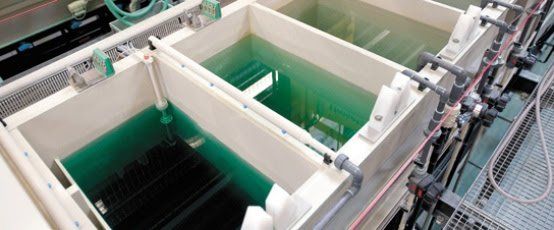Tech Talk
Up-to-date information that helps you level up with today's ever growing plating industry.
RHL Associates, LLC is your go-to-expert for supplies, equipment and knowledge.
Buyers often make incorrect assumptions about the chemistry of the solution to be heated.
For example, a buyer using stainless steel tanks may specify stainless steel heaters thinking that the tank didn't corrode so the heaters will be OK. Actually,
heat accelerates corrosion rates
dramatically. Given the composition of a particular solution and the addition of heat, the stainless steel sheath covering the heater would have corroded at a faster rate than the tank material.
All chemicals and additives in the tank should be checked before ordering immersion heaters.
It may be possible for a variety of materials to be acceptable, such as Titanium or 316 Stainless Steel in Deionized water, while chemistries such as hydrochloric acid would require PTFE heaters only.
KEEP READING and DOWNLOAD YOUR FOUR FREE GUIDES AND CHARTS
It is also important to take into consideration the
operating temperature and concentration of the process solution. Higher concentrations (20% or higher) may require a lower watt density element so that the optimum heat transfer can take place without causing premature failure to the element. In these applications it is the ability of the fluid to accept heat which is the limiting factor in selecting the watt density. In general the more viscous the solution the lower the heater watt density needs to be. Derated (20 wsi or less) heaters are ideal for these chemistries.
A process selector for both Electric Immersion Heaters and Immersion Coils is now available on our website.
Be sure to check all chemistries in your process tank.
Also check with the chemical manufacturer to find out what they specify and how to best clean and maintain the equipment that goes into your process tank.
Shared September 15th, 2017
By Connie Dawson, Process Technology
Download these important Process Technology PDF guides and charts to
your desktop for future reference:
DOWNLOAD ALL FOUR GUIDES AND CHART
↓
DOWNLOAD ALL FOUR GUIDES AND CHART
↓ ↓ ↓ ↓
Call us today
for all your equipment and supply needs! We're here everyday of the year to answer all your questions and to provide you with the expert knowledge you need.
RHL Associates accepts:



CORPORATE OFFICE
RHL Associates, LLC
11 Schooner Way
Marshfield, MA 02050 USA
CONTACT
T: (978) 273-8100
F: (978) 440-8133
rhl8100@aol.com
Nationwide USA
SUPPORT HOURS
7AM - 7PM
7 Days A Week
RHL Associates , LLC, Industries Served: Plating, Metal Finishing, Surface Finishing, Chemical Processing, Printed Circuit Board, Anodizing, Electropolishing, Jewelry, Semiconductor, Microelectronics, Photovoltaic. Representative States Served:AL, AZ, CA, CO, CT, DE, FL, GA, IL, IN, KS, KY, LE, MA, MD, ME, MI, MN, NH, NJ, NY, PA, RI, SC, TX, UT, VA, VT, WA, WI.
Logos and trademarks are the property of their respective owners, this includes equipment and product images.



